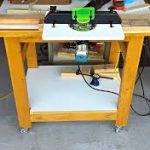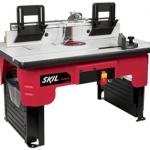Last Updated on April 29, 2021 by James
If you’re as much of a woodworking genius as Sam Maloof, you’re much more likely to have some of your own tricks and tips on woodworking down, perhaps even written them down in a notebook to remember as well as be able to teach your own kids a few tactics. Or perhaps you are that kid, your parents have already provided you with a few tips and tricks to help you improve your woodworking. But the more likely philosophy at play here is that of you being a newbie, just starting out with woodworking, so here we are, trying to pass down our tips and tricks to the family.
Woodworking is an art, and we all understand this but tend to forget it in the face of a machine. Router tables though are definitely one of the few pieces of machinery out there that can help you regain that artistic sense and freedom when woodworking in your shed or garage. While using the best router table alone may seem easier, the table adds to the versatility and precision of the machine, making small edges and molding projects an easier job to perform with the safety of the table increases its usability
Similarly, you can now expand on your knowledge of woodworking on the router table by gauging on these tips and tricks that we’ve collected so far.
- Utilizing two feather boards on the router table ensures accuracy when shaping the wood. These contraptions help hold the wood in place to be able to handle the smallest of cuts, without injuring yourself the slightest. These cuts, while still being tiny, resulting in smoother and straight cuts than with you holding on to the wood.
- When making cuts on thin or narrow wood stock, routing the profile on the wide board, while handling the edges on the table saw, is an easier, safer, and efficient solution. This is highly effective when shaping moldings.
- When looking at shaping identical twin pieces, for an appliance like a box or so, using pattern bits or even a template that can be adjusted onto the height of the wood. Most of these are provided in thinner width, so as to not take up too much of your energy.
- Create a customized baseplate to help you with measurements, specifically when working on dados. Starting with 0 at the base, you can include a change at an interval between a constant difference among the measurements.
- With a starting ramp and an exit ramp on the template, following through with the entire cut becomes much easier to practice.
- While making sleds, you’ll notice that many of them seem to have a subtle problem with producing misaligned joints, specifically due to the base. To produce a rigid one with strong joints, you’ll need to add a board at the front of the sled, while including two top boards that bridge over the workpiece.
- You could use clamps while cutting tenons, specifically utilizing a thinner bit for the router, to get the rail looking efficiently cut.
- Over 40 degrees the milters on the table saw seem to find it more difficult to be cut. The alignment of the blade produces a burnt edge of sorts. If this is a regular occurrence for you when trying to cut a milter, try using a chamfer bit, which are perfect for cutting above the 45-degree limitation.
- To make chip-free dados, consider down-cut bits. These usually push down the chips to make a smoother cut out of the wood.
- Wider boards are hard to flatten if they won’t even fit through your table. Getting two guideboards situated onto your wide board, along with installing a large-diameter bit on your router, and you’re ready to tackle this problem.
We’d like to provide a few safety tips before you start working on these lovely fascinating new techniques:
- Wear safety glasses while protecting your ears with a guard.
- When interchanging a bit for another, do unplug your router, or simply switch it off.
- Feed the food counter-clockwise, always, never climb cut, especially if you also want efficient cuts.
- Overloading the router or simply forcing the bit into it will cause problems in the long run
- Using push blocks, make sure your arms are farther from the action.
- Take lighter cuts, heavy cuts tend to incite larger chunks of kick back.
- Make sure all the locking devices, bits, clamps, etc. are in place before you switch the router on.
- While starting the router, to help resist the initial motor torque, hold on to the machinery tightly.
- Avoid operating electrical routers in humid, moist, or wet areas.
- Keep the machinery well maintained, replacing bad parts early on.



